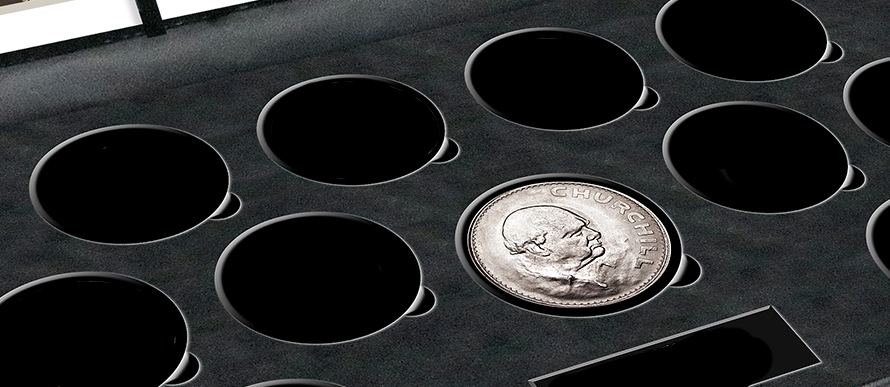
The “Crown” has a long history as a currency coin dating all the way back to the time of Henry VIII. In more recent times the crown has been struck as a commemorative coin to mark significant royal events such as birthdays, weddings or jubilees. Here, we take a look at the crown’s origins and how it has changed since then.
The beginning
In 1526, King Henry VIII pushed through his monetary reform and the “Crown”, or “Crown of the Double Rose” as it was originally called, came into existence. It had a value of five shillings. The first crown coins were minted in 22 carat gold, which was much more durable than 24 carat gold.
The first silver crowns were introduced during the reign of Kind Edward VI in 1551 and the coins continued to be minted in both gold and silver throughout the reigns of Elizabeth I, James I and Charles I.
The silver crown was made of “sterling silver” which, like its gold companion, was a hard wearing and durable alloy. The hardness of these coins helped to prevent “clipping”, which was a practice used by counterfeiters of literally clipping the edge of softer coins, without drastically altering their shape, in order to make new coins. The advent of the milled edge also discouraged this practice.
A new name
The year 1707 saw the Acts of Union, which, following the Treaty of Union the previous year, brought together the nations of England and Scotland to form the United Kingdom of Great Britain. With it came a new coin named the “British Crown”, which became the successor to the English crown and the Scottish dollar.
From 1751, the crown ceased to be struck due to a lack of silver. Following “The Great Recoinage” of 1816 however, which was to bring about stability to British currency following the Napoleonic and French Revolutionary wars, the silver crown began to be minted once more from 1818.
The design that adorned these new crowns was the famous image of St George and the Dragon, designed by Benedetto Pistrucci. By the time of Queen Victoria’s reign, Pistrucci and his designs had fallen out of favour and so the early crowns of her reign featured the Shield of Arms. Then, in 1847, the design changed to a gothic inspired rendering of the four shields of arms and even a gothic portrait of the Queen on the other side. For forty years, from 1847 to 1887, there were no crowns produced at all. Then, in 1887, for the Golden Jubilee of Queen Victoria, the crown was minted once again, and with Pistrucci’s design of St George.
A change in composition
The crown had always been quite a heavy coin weighing in at one ounce. Over the years this made it more and more unpopular as a currency coin and after 1902, the crown was no longer struck for everyday use but continued to be struck for commemorative purposes marking special occasions.
Due to the First World War taking its toll on the British economy, in 1920, the crown was reduced from 92.5% silver to just 50%. During King George V’s reign, a new design adorned a small number of crowns that were struck; that of a crown within a wreath. There was then a large number of crowns struck for King George V’s Silver Jubilee in 1935.
During the reign of King George VI, two further crowns were produced. The first had a royal coat of arms on the reverse, which was struck in 1937, and in 1951 the first ever cupronickel crown was struck, which was 75% copper and 25% nickel to mark the Festival of Britain and the 400th anniversary of the first silver crown coin.
A new crown was issued in 1953, to celebrate the coronation of our present monarch, Queen Elizabeth II. The 1960 crown was struck to mark the British Exhibition in New York. In 1965 a crown was released to mark the death of Winston Churchill and it was the first time ever that a “non-monarch” or “commoner” had featured on the coin. That particular coin features in our “Britain’s Last Pre-Decimal Final Year Date Heritage Set” which you can view HERE.
Post-Decimalisation
The crown was worth five shillings before decimalisation in 1971 and the last five shilling piece was minted in 1965. In 1972 the “Twenty-Five Pence” coin replaced the crown as a commemorative coin and it did not have its value stated on it, as crown coins rarely did either. Although released as a commemorative coin it was actually legal tender.
The Royal Mint discontinued the coin after 1981 due to the cost of minting such a large coin with such a low monetary value. In 1990 the crown was revived as a “Five Pound” coin, the same size as a crown but with a value twenty times greater.
The crown continues, nearly five hundred years after its inception, to be an enduring piece of British coinage.
From the viewpoint of coin collecting, the term “crown-sized” is generically used to describe large silver or cupronickel coins of about 38-40mm in diameter, two of which make up our “Queen Elizabeth II 2021 The 95th Birthday Commemorative Two Coin Set” which is available HERE.


